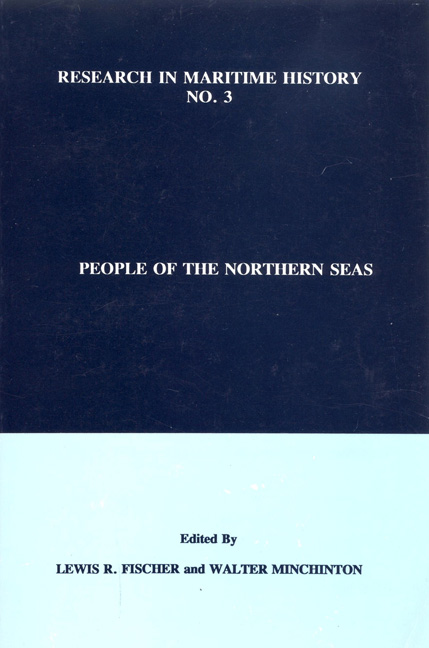Book contents
- Frontmatter
- Contents
- About the Editors
- Contributors
- General Introduction
- “Une Petite Republique” in Southwestern Newfoundland: The Limits of Imperial Authority in a Remote Maritime Environment”
- “Changes in Aleut Communities Following Russian Contact”
- “Five Years Before the Mast: Observations on the Conditions of Maritime Labour in Finland and Elsewhere”
- “Expressions of Longing, Sources of Anxiety? The Significance of Contacts with Home for Finnish Sailors in London and Hull in the Late Nineteenth Century”
- “Death of a Merchant”
- “St. Petersburg's Bills of Exchange in the Russian Economy of the Eighteenth Century”
- “Shipowners and Iron Sailing Ships: The First Twenty Years, 1838-1857”
- “The Growth of Norwegian Shipbroking: The Practices of Fearnley and Eger as a Case Study, 1869-1914”
- “Captain John Deane: Mercenary, Diplomat and Spy”
- “Her Majesty's Coastguard”
- “Coastal Life, ‘Nordic Culture’ and Nation State: Reflections on the Formation of the Nation State and Maritime History”
“Death of a Merchant”
- Frontmatter
- Contents
- About the Editors
- Contributors
- General Introduction
- “Une Petite Republique” in Southwestern Newfoundland: The Limits of Imperial Authority in a Remote Maritime Environment”
- “Changes in Aleut Communities Following Russian Contact”
- “Five Years Before the Mast: Observations on the Conditions of Maritime Labour in Finland and Elsewhere”
- “Expressions of Longing, Sources of Anxiety? The Significance of Contacts with Home for Finnish Sailors in London and Hull in the Late Nineteenth Century”
- “Death of a Merchant”
- “St. Petersburg's Bills of Exchange in the Russian Economy of the Eighteenth Century”
- “Shipowners and Iron Sailing Ships: The First Twenty Years, 1838-1857”
- “The Growth of Norwegian Shipbroking: The Practices of Fearnley and Eger as a Case Study, 1869-1914”
- “Captain John Deane: Mercenary, Diplomat and Spy”
- “Her Majesty's Coastguard”
- “Coastal Life, ‘Nordic Culture’ and Nation State: Reflections on the Formation of the Nation State and Maritime History”
Summary
At the production end of the many chains of maritime contact between the peripheral north and the populous core of western Europe during the pre-industrial era, seaport merchants played key roles in co-ordinating the supply and transport of staples. Unfortunately, most of the business records of eighteenth and early nineteenth-century merchants in the port of Luleâ in northern Sweden have been misplaced or destroyed. Alternatives must therefore be employed to investigate the patterns and organisation of trade in the Lule River valley. In the Regional Archives at Härnösand, estate inventories are preserved for a number of Luleâ's wealthier citizens; this is a useful beginning for a study of the role of the merchant in the utilisation of resources in the town's extensive hinterland. One such inventory is analyzed here to illustrate its scholarly value. Furthermore, an attempt is made “to see the universe in the locality” by drawing some general conclusions from the study of an individual.
Abraham Stenholm, a Luleâ merchant, died of dropsy (a rich man's disease) on 7 May 1821. According to his inventory, he left a widow, Elisabeth, and three young children-Adam, Carl Frederic, and Frederica Elisabeth-for whom the alderman Abraham Ruth and the merchant Anders Magnus Söderholm were appointed guardians. The fact that the children were still minors suggests that their father was not particularly old; indeed, the parish catechetical registers show that Abraham was born on 4 December 1773 and was therefore only fortyseven at the time of his death. The same sources also reveal that the surname “Stenholm” did not figure among Luleâ's merchants until 1806. Having moved to town from die neighbouring rural parish of Râneâ in 1790, Abraham Stenholm was first recorded as an assistant living in the household of the young merchant Abraham Ruth, who was only eight years his senior. There were several branches of Ruths living in town, and the family had mercantile traditions pre-dating the establishment of Luleâ in 1621. During the following two centuries the family name also featured prominently among the town's aldermen and mayors.
- Type
- Chapter
- Information
- People of the Northern Seas , pp. 81 - 98Publisher: Liverpool University PressPrint publication year: 1992



